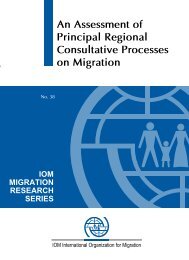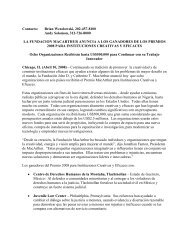A Global Compact on Learning - Brookings Institution
A Global Compact on Learning - Brookings Institution
A Global Compact on Learning - Brookings Institution
You also want an ePaper? Increase the reach of your titles
YUMPU automatically turns print PDFs into web optimized ePapers that Google loves.
seven. At these centers, children are provided with<br />
60 percent of their daily nutriti<strong>on</strong>al requirements<br />
and are supervised by “community” mothers, who<br />
are selected from am<strong>on</strong>g women in the community.<br />
These community mothers are trained in nutriti<strong>on</strong>,<br />
health, hygiene, and recreati<strong>on</strong>; they are paid a salary;<br />
and they receive assistance in obtaining home<br />
improvement loans. After six years, the community<br />
day care program reached 1 milli<strong>on</strong> children. 90<br />
Four main acti<strong>on</strong>s need to be pursued to achieve<br />
Strategy 1A:<br />
• Invest in nutriti<strong>on</strong>, health, and livelihoods<br />
support.<br />
• Develop comprehensive ECD frameworks<br />
and plans.<br />
• Provide support programs that promote adequate<br />
stimulati<strong>on</strong> and good parenting and<br />
caregiving.<br />
• Strengthen program standards, support,<br />
and professi<strong>on</strong>al training for ECD educators<br />
and caregivers.<br />
The first needed acti<strong>on</strong> is to invest in nutriti<strong>on</strong>,<br />
health, and livelihoods support. Because learning<br />
can (and should) take place c<strong>on</strong>tinuously throughout<br />
<strong>on</strong>e’s life, both in and out of the classroom,<br />
interventi<strong>on</strong>s to improve cognitive development<br />
require investments bey<strong>on</strong>d educati<strong>on</strong> policy—<br />
such as investments in nutriti<strong>on</strong>, potable water,<br />
and livelihood support for families with infants<br />
and small children. 91 For example, in Vietnam, a<br />
preschool nutriti<strong>on</strong> program was associated with<br />
higher test scores in grades 1 and 2. 92 In Bangladesh,<br />
the provisi<strong>on</strong> of eight fortified biscuits a day<br />
to approximately 1 milli<strong>on</strong> children in 6,000 primary<br />
schools resulted in 28 percent higher mathematics<br />
scores after <strong>on</strong>e year than those in c<strong>on</strong>trol<br />
schools. 93 Therefore, improving early learning requires<br />
multisectoral coordinati<strong>on</strong> and integrated<br />
approaches because the business of learning is not<br />
just the work of educati<strong>on</strong> actors. Although the<br />
examples given here come from primary schools,<br />
these types of interventi<strong>on</strong>s should also, and foremost,<br />
be implemented in ECD programs to mitigate<br />
the irreversible effects of early malnutriti<strong>on</strong> <strong>on</strong><br />
children (see box 2.1).<br />
Box 2.1. Improving Child Health—and School<br />
Enrollment Rates—in Bolivia<br />
In Bolivia, poor families tend to have high rates<br />
of child mortality and malnutriti<strong>on</strong>, low rates of<br />
primary school attendance, and a greater likelihood<br />
of repetiti<strong>on</strong> and dropouts. The early<br />
childhood development program Projecto Integral<br />
de Desarollo Infantil, which provides<br />
comprehensive home-based day care for impoverished<br />
families, was established to better<br />
prepare children to enter and succeed in school,<br />
empower women through employment opportunities,<br />
and increase community participati<strong>on</strong><br />
in childhood development. Each center serves<br />
fifteen children ranging from six m<strong>on</strong>ths to six<br />
years old and is led by a mother or caretaker<br />
who is assisted by helpers. Children receive two<br />
meals and a snack per day (providing 70 percent<br />
of their daily caloric needs), receive basic<br />
health care, and engage in games and physical<br />
activity to foster cognitive development. Almost<br />
all children who leave the program at the age of<br />
six enter primary school, a significant increase<br />
from the 20 percent enrollment rate for children<br />
not in the program. These results are attributed<br />
to improved children’s health as well as parents’<br />
participati<strong>on</strong> in the program.<br />
Source: J. van der Gaag and J. Tan, Benefits of Early Childhood<br />
Development Programs: An Ec<strong>on</strong>omic Analysis (Washingt<strong>on</strong>: World<br />
Bank, 1998).<br />
The sec<strong>on</strong>d needed acti<strong>on</strong> is to develop comprehensive<br />
ECD frameworks and plans. In many countries,<br />
ECD is a low priority and the quality of services<br />
has been poor and fragmented. In some areas, the<br />
private and n<strong>on</strong>-profit sectors have been primarily<br />
resp<strong>on</strong>sible for providing ECD without adequate<br />
resources, regulati<strong>on</strong>, or quality assurance from the<br />
government. 94 Governments should develop a comprehensive<br />
framework or shared plan of acti<strong>on</strong> for<br />
ECD that addresses the rights and needs of all children—especially<br />
the poorest—and that is supported<br />
by informati<strong>on</strong> and m<strong>on</strong>itoring systems. 95 This will<br />
require collaborati<strong>on</strong> and coordinati<strong>on</strong> am<strong>on</strong>g ministries<br />
and organizati<strong>on</strong>s—especially ministries of<br />
A <str<strong>on</strong>g>Global</str<strong>on</strong>g> Compa c t <strong>on</strong> <strong>Learning</strong>: Taking Acti<strong>on</strong> <strong>on</strong> Educat i o n in Developing Countries<br />
C e n t e r for Universal Educat i o n at <strong>Brookings</strong><br />
19






